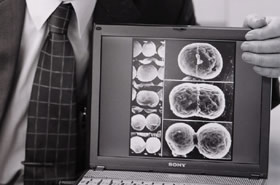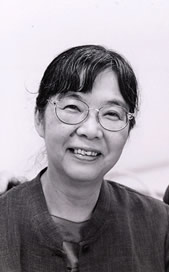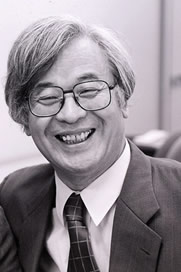 |
| My encounter with observation |
 |
 |
To take a photograph that anyone can understand at a glance requires hours and days of searching while envisioning a three-dimensional body from an ultra-thin section of a cell or organelle. One looks through the microscope with one's heart. Once you've found it, anyone can look for it. There are many methods for finding a new phenomenon, but in my case, I look through the microscope.
I was a real devil in primary school. I was great at fighting and judo, but was a terrible student. I was saved by my dexterity and sharp eyes. When I saw mold growing in miso using a microscope I bought at a night stall, I discovered a micro-world where ticks wriggled. I was surprised and moved.
Until high school, judo was my primary ambition, but I had to give it up when I contracted tuberculosis. I thought about becoming an artist or sculptor, and attended an art preparatory school. I realized I had no talent, however, and spent some dreary, depressing days after that. My final choice was to become a biologist and use a microscope. Since then, I've been going at it full tilt. |
 |
| The discovery of the mitochondria nucleus |
 |
 |
I think that the essence of life is multiplication. I entered the Tokyo Metropolitan University in 1962 to study with developmental biologist Dr. ?Katsuma Dan. Dr. Dan stressed that the requirements for original research were the choice of materials and the development of a method. On a sketch done during an sea side practice at the Misaki shore, I wrote "What is this?", indicating the constriction of the blastomere of a sea urchin during cleavage. That was my starting point.
For my graduation research, I analyzed the structure of a chromosome using an electron microscope. At graduate school, I elucidated the correlation between the changes in the chromosome structure and function. I already had a job, but I wanted to do basic research, so I went to Okayama University in 1973. I discovered that when the genes began to move vigorously, some of the chromosomes immediately became flaccid. Therefore, I tried to isolate this substance. Nuclear division is not synchronized in the meristematic tissue of Plants and animals, however, so it is unsuitable. I had the idea that the nucleus of the physarum polycephalum plasmodium might divide in synchronization. When I used it, I unexpectedly discovered that the DNA of mitochondria had a nuclear structure. This ran counter to the conventional wisdom that the DNA of an organelle or bacteria was free. I was excited. The organelle was a descendant of bacteria that coexisted inside a cell two billion years ago, so this division and multiplication was extremely interesting as a research model for cellular division. I eagerly changed the subject of my research to organelles. |
 |
| Discovery of the organelle division ring |
 |
 |
In 1977, at the invitation of Prof. Noburo Kamiya, I moved to the Okazaki National Institute for Basic Biology. I developed a high-resolution fluorescence microscope that could distinguish a single gene, discovered that the organelle DNA of most creatures had a nuclear structure, and proposed the “Theory of Tri-Nuclear Cells. There are many organelles in a cell, and I had difficulty because they broke up and dispersed. So, I began to see Cyanidum caldarium which has single set of each organelle. I thought there should be a division mechanism corresponding to the cell body division, and searched for the equator during division.
In 1986 I discovered the mitotic apparatus of the chloroplast (PD ring). I noticed that the PD ring was universal among Plants. I went to Italy in search of the smallest eucaryote. In addition to the huge PD ring, I also discovered the mitotic apparatus of the mitochondria (MD ring), in the simple model red algae cell (Cyanidioschyzon merolae, commonly known as the schyzon) separated from hot spring algae. I had continuously been looking for the form of "What is this?" from the constriction of the sea urchin. I was persistent, if I do say so myself (laughs). |
 |
| Elucidating the organelle's division mechanism |
 |
 |
The final means for elucidating the entire aspect of the organelle's division mechanism is the analysis of the genome. We determined the entire base sequence of the three genomes of the schyzon chloroplast, mitochondria, and cell nucleus. The dynamin gene emerged in this process. In both the mitochondria and the chloroplast, the dynamin gene product formed a ring only in the final division, and we divided the daughter organelle. A total of five rings converged in time and space. They were used in the chloroplast division. These were the FtsZ ring, involved in determining the fission plane, three types of PD rings, involved in the contractile force, and finally the dynamin ring dividing the daughter chloroplast. Roughly the same mechanism functions in the mitochondria division.
The genes of the dynamin and the PD ring have not yet been found in the genome of the prokaryotic organism. When the eucaryotic cell was created two billion years ago, these rings may have played the crucial role as the host that controlled the division of the mitochondria and chloroplast ancestor bacteria.
The essence of the organelle division mechanism that we have understood is both simple and beautiful. If this can be controlled, it might be utilized to deal with the urgent problems we face in the 21st century, including global warming, desertification, and starvation. When I see the mitochondria and chloroplast under the microscope, I can only believe they are performing a grand drama of past, present, and future.
(Text: SICP)
|
|
|
| My partner, Dr. Haruko Kuroiwa, and I have always been together since we worked jointly on our graduation research. She has maintained a consistent interest in the mechanism of double fertilization in the higher plants. I realized once again that when I gained this wonderful partner for life that I was able to devote myself to one thing. |
|
 |
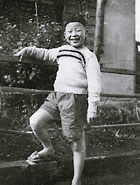 |
 Entered primary school in 1948. Entered primary school in 1948. |
 |
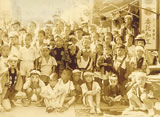 |
 Third grade in primary school, at a festival, which I loved Third grade in primary school, at a festival, which I loved
Last row, to the left and below the lantern. |
 |
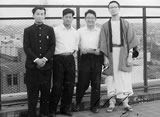 |
 In 1959 with other judo club members on the roof of a hospital. I am on the end at right. In 1959 with other judo club members on the roof of a hospital. I am on the end at right. |
 |
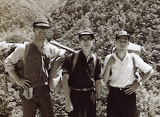 |
 Fishing at a mountain stream with the members of the university fishing club. I am on the end at right. Fishing at a mountain stream with the members of the university fishing club. I am on the end at right. |
 |
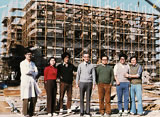 |
 In 1977, in front of the Okazaki National Institute for Basic Biology under construction. I am on the end at left. The fourth person from the left is Dr. Kamiya. In 1977, in front of the Okazaki National Institute for Basic Biology under construction. I am on the end at left. The fourth person from the left is Dr. Kamiya. |
 |
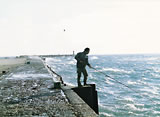 |
 Caught a black porgy at Lake Hamana. Stayed until I was alone with a sea gull. Caught a black porgy at Lake Hamana. Stayed until I was alone with a sea gull. |
 |
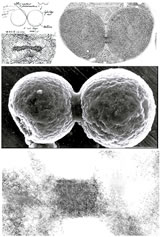 |
The form of division that I pursued
The development of the form of division as seen through electron microscopes, starting with a sketch of a sea urchin egg (upper left) and moving to nuclear division in the mitochondria of slime mold (lower left), a simple model red algae cell cyanidium (upper right) and the schyzon chloroplast (center, right). The power of division comes from a four nano diameter PD/MD ring, the "lifeline of humankind and the spool of dreams" |
|
|
 |
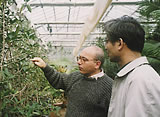 |
 1992, to the University of Naples in search of schyzon. 1992, to the University of Naples in search of schyzon.
At the Botanical Garden with Prof. Marco. |
 |
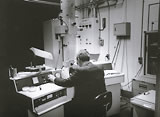 |
 1993--discovered the mitotic apparatus of mitochondria using an electron microscope. 1993--discovered the mitotic apparatus of mitochondria using an electron microscope. |
 |
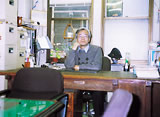 |
 At the faculty room on the main campus at the University of Tokyo At the faculty room on the main campus at the University of Tokyo
The desk was used by Prof. Dan at Misaki. |
 |
|

